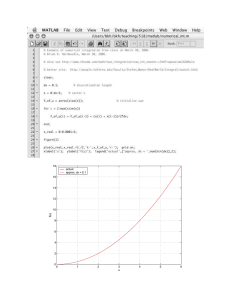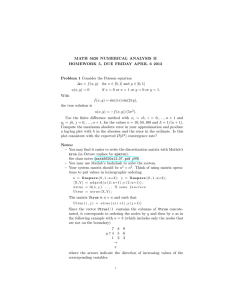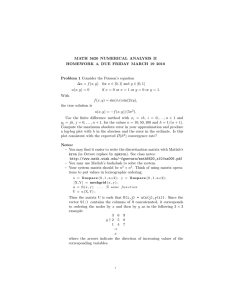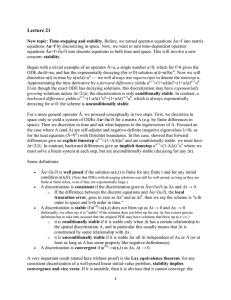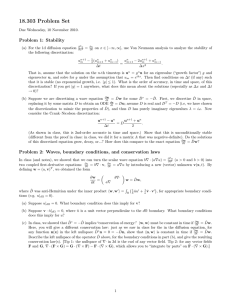Abstract
advertisement
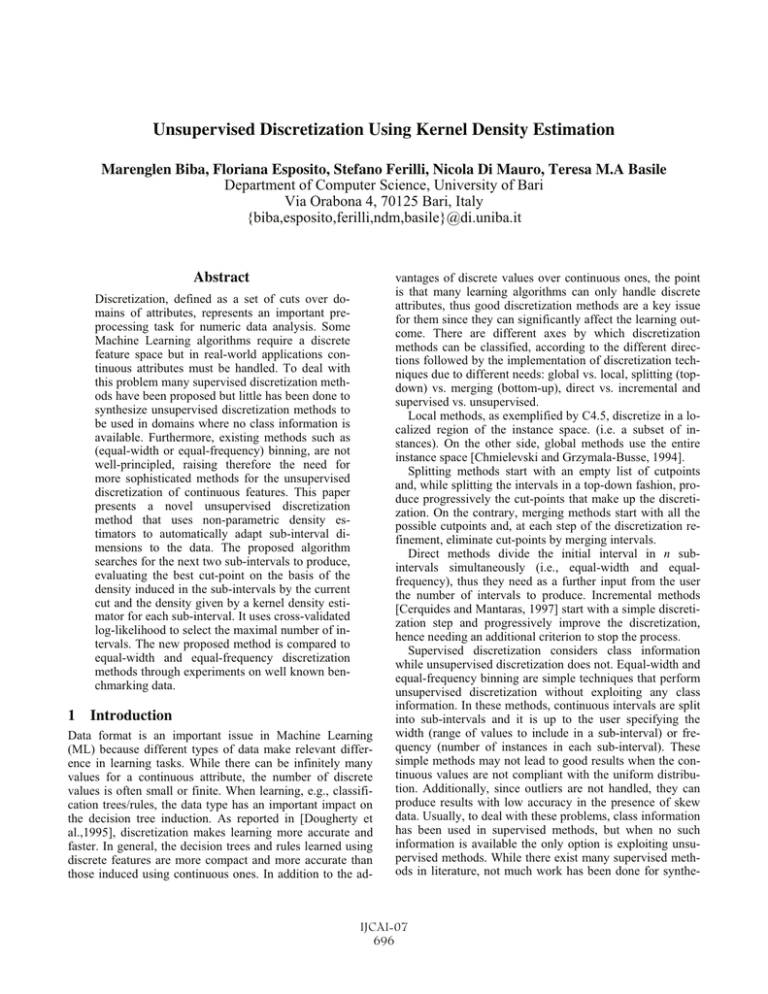
Unsupervised Discretization Using Kernel Density Estimation
Marenglen Biba, Floriana Esposito, Stefano Ferilli, Nicola Di Mauro, Teresa M.A Basile
Department of Computer Science, University of Bari
Via Orabona 4, 70125 Bari, Italy
{biba,esposito,ferilli,ndm,basile}@di.uniba.it
Abstract
Discretization, defined as a set of cuts over domains of attributes, represents an important preprocessing task for numeric data analysis. Some
Machine Learning algorithms require a discrete
feature space but in real-world applications continuous attributes must be handled. To deal with
this problem many supervised discretization methods have been proposed but little has been done to
synthesize unsupervised discretization methods to
be used in domains where no class information is
available. Furthermore, existing methods such as
(equal-width or equal-frequency) binning, are not
well-principled, raising therefore the need for
more sophisticated methods for the unsupervised
discretization of continuous features. This paper
presents a novel unsupervised discretization
method that uses non-parametric density estimators to automatically adapt sub-interval dimensions to the data. The proposed algorithm
searches for the next two sub-intervals to produce,
evaluating the best cut-point on the basis of the
density induced in the sub-intervals by the current
cut and the density given by a kernel density estimator for each sub-interval. It uses cross-validated
log-likelihood to select the maximal number of intervals. The new proposed method is compared to
equal-width and equal-frequency discretization
methods through experiments on well known benchmarking data.
1 Introduction
Data format is an important issue in Machine Learning
(ML) because different types of data make relevant difference in learning tasks. While there can be infinitely many
values for a continuous attribute, the number of discrete
values is often small or finite. When learning, e.g., classification trees/rules, the data type has an important impact on
the decision tree induction. As reported in [Dougherty et
al.,1995], discretization makes learning more accurate and
faster. In general, the decision trees and rules learned using
discrete features are more compact and more accurate than
those induced using continuous ones. In addition to the ad-
vantages of discrete values over continuous ones, the point
is that many learning algorithms can only handle discrete
attributes, thus good discretization methods are a key issue
for them since they can significantly affect the learning outcome. There are different axes by which discretization
methods can be classified, according to the different directions followed by the implementation of discretization techniques due to different needs: global vs. local, splitting (topdown) vs. merging (bottom-up), direct vs. incremental and
supervised vs. unsupervised.
Local methods, as exemplified by C4.5, discretize in a localized region of the instance space. (i.e. a subset of instances). On the other side, global methods use the entire
instance space [Chmielevski and Grzymala-Busse, 1994].
Splitting methods start with an empty list of cutpoints
and, while splitting the intervals in a top-down fashion, produce progressively the cut-points that make up the discretization. On the contrary, merging methods start with all the
possible cutpoints and, at each step of the discretization refinement, eliminate cut-points by merging intervals.
Direct methods divide the initial interval in n subintervals simultaneously (i.e., equal-width and equalfrequency), thus they need as a further input from the user
the number of intervals to produce. Incremental methods
[Cerquides and Mantaras, 1997] start with a simple discretization step and progressively improve the discretization,
hence needing an additional criterion to stop the process.
Supervised discretization considers class information
while unsupervised discretization does not. Equal-width and
equal-frequency binning are simple techniques that perform
unsupervised discretization without exploiting any class
information. In these methods, continuous intervals are split
into sub-intervals and it is up to the user specifying the
width (range of values to include in a sub-interval) or frequency (number of instances in each sub-interval). These
simple methods may not lead to good results when the continuous values are not compliant with the uniform distribution. Additionally, since outliers are not handled, they can
produce results with low accuracy in the presence of skew
data. Usually, to deal with these problems, class information
has been used in supervised methods, but when no such
information is available the only option is exploiting unsupervised methods. While there exist many supervised methods in literature, not much work has been done for synthe-
IJCAI-07
696
sizing unsupervised methods. This could be due to the fact
that discretization has been commonly associated with the
classification task. Therefore, work on supervised methods
is strongly motivated in those learning tasks where no class
information is available. In particular, in many domains,
learning algorithms deal only with discrete values. Among
these learning settings, in many cases no class information
can be exploited and unsupervised discretization methods
such as simple binning are used.
The work presented in this paper proposes a top-down,
global, direct and unsupervised method for discretization. It
exploits density estimation methods to select the cut-points
during the discretization process. The number of cutpoints is
computed by cross-validating the log-likelihood. We consider as candidate cutpoints those that fall between two instances of the attribute to be discretized. The space of all the
possible cut-points to evaluate could grow for large datasets
that have continuous attributes with many instances with
different values among them. For this reason we developed
and implemented an efficient algorithm of complexity
Nlog(N) where N is number of instances.
The paper is organized as follows. In Section 2 we describe non-parametric density estimators, a special case of
which is the kernel density estimator. In Section 3 we present the discretization algorithm, while in Section 4 we report experiments carried out on classical datasets of the UCI
repository. Section 5 concludes the paper and outlines future
work.
2
value in x, every other point in the same bin, contributes
equally to the density in x, no matter how close or far away
from x these points are.
Figure 1. Simple binning places a block in every
sub-interval for every instance x that falls in it
This is rather restricting because it does not give a real mirror of the data. In principle, points closer to x should be
weighted more than other points that are far from it. The
first step in doing this is eliminating the dependence on bin
origins fixed a-priori and place the bin origins centered at
every point x. Thus the following pseudo-formula:
Non-parametric density estimation
n
Since data may be available under various distributions, it is
not always straightforward to construct density functions
from some given data. In parametric density estimation, an
important assumption is made: available data has a density
function that belongs to a known family of distributions,
such as the normal distribution or the Gaussian one, having
their own parameters for mean and variance. What a parametric method does is finding the values of these parameters
that best fit the data. However, data may be complex and
assumptions about the distributions that are forced upon the
data may lead to models that do not fit well the data. In these cases, where making assumptions is difficult, nonparametric density functions are preferred.
Simple binning (histograms) is one of the most wellknown non-parametric density methods. It consists in assigning the same value of the density function f to every
instance that falls in the interval [C – h/2, C + h/2), where C
is the origin of the bin and h is the binwidth. The value of
such a function is defined as follows (symbol # stands for
‘number of’):
f =
1
n h
# {instances that fall in C
h
,C
2
h
}
2
Once fixed the origin C of a bin, for every instance that falls
in the interval centered in C and of width h, a block of size 1
by the bin width is placed over the interval (Figure 1). Here,
it is important to note that, if one wants to get the density
1
# {instances that fall in a bin
binwidth
containing x}
should be transformed in the following one:
1
# {instances that fall in a bin around x}
n binwidth
The subtle but important difference in constructing binning
density with the second formula, permits to place the bin
around x and the calculation of the density is performed not
in a bin containing x and depending from the origin C, but
in a bin whose center is upon x. The bin center on x, allows
successively to assign different weights to the other points
in the same bin in terms of impact upon the density in x depending on the distance from x. If we consider intervals of
width h centered on x, then the density function in x is given
by the formula:
f =
1
# {instances that fall in [x
2hn
h, x h]}
In this case, when constructing the density function, a box
of width h is placed for every point that falls in the interval
centered in x. These boxes (the dashed ones in Figure 2) are
then added up, yielding the density function of Figure 2.
This provides a way for giving a more accurate view of
what the density of the data is, called box kernel density
IJCAI-07
697
estimate. However, the weights of the points that fall in the
same bin as x have not been changed yet.
Figure 2. Placing a box for every instance in the interval
around x and adding them up.
In order to do this, the kernel density function is introduced:
p=
x Xi
1 n
K
nh i 1
h
where K is a weighting function. What this function does is
providing a smart way of estimating the density in x, by
counting the frequency of other points Xi in the same bin as
x and weighting them differently depending on their distance from x. Contributions to the density value of f in x
from points Xi vary, since those that are closer to x are
weighted more than points that are further away. This property is fulfilled by many functions, that are called kernel
functions. A kernel function K is usually a probability density functions that integrates to 1 and takes positive values
in its domain. What is important for the density estimation
does not reside in the kernel function itself (Gaussian,
Epanechnikov or quadratic could be used) but in the bandwidth selection [Silverman 1986]. We will motivate our
choice for the bandwidth (the value h in the case of kernel
functions) selection problem in the next section where we
introduce the problem of cutting intervals based on the density induced by the cut and the density given by the above
kernel density estimation.
3
Where and what to cut
The aim of discretization is always to produce sub-intervals
whose induced density over the instances best fits the available data. The first problem to be solved is where to cut.
While most supervised top-down discretization method cut
exactly at the points in the main interval to discretize that
represent instances of the data, we decided to cut in the
middle points between instance values. The advantage is
that this cutting strategy avoids the need of deciding
whether the point at which the cut is performed is to be included in the left or in the right sub-interval.
The second question is which (sub-)interval should be
cut/split next among those produced at a given step of the
discretization process. Such a choice must be driven by the
objective of capturing the significant changes of density in
different separated bins. Our proposal is to evaluate all the
possible cut-points in all the sub-intervals, by assigning to
each of them a score according to a method whose meaning
is as follows. Given a single interval to split, any of its cutpoints produces two bins and thus induces upon the initial
interval two densities, computed using the simple binning
density estimation formula. Such a formula, as shown in the
previous section, assigns the same density value of the function f to every instance in the bin and ignores the distance
from x of the other instances of the bin when computing the
density in x. Every sub-interval produced has an averaged
binned density (the binned density in each point) that is different from the density estimated with the kernel function.
The less this difference is, the more the sub-interval fits the
data well, i.e. the better this binning is, and hence there is no
reason to split it. On the contrary, the idea underlying our
discretization algorithm is that, when splitting, one must
search for the next two worst sub-intervals to produce,
where “worst” means that the density shown by each of the
sub-intervals is much different than it would be if the distances among points in the intervals and a weighting function were considered. The identified worst sub-intervals are
just those to be split to produce other intervals, because they
do not fit the data well. In this way intervals whose density
differs much from the real data situation are eliminated, and
replaced by other sub-intervals. In order to achieve the density computed by the kernel density function we should reproduce a splitting of the main interval such as that in Figure 2.
An obvious question that arises is: when a given subinterval is not to be cut anymore? Indeed, searching for the
worst sub-intervals, there are always good candidates to be
split. This is true, but on the other hand at each step of the
algorithms we can split only one sub-intervals in other two.
Thus if there are more than one sub-interval (this is the case
after the first split) to be split, the scoring function of the
cut-points allows to choose the sub-interval to split.
3.1 The scoring function for the cutpoints
At each step of the discretization process, we must choose
from different sub-intervals to split. In every sub-interval we
identify as candidate cut-points all the middle points between the instances. For each of the candidate cut-points T
we compute a score as follows:
k
IJCAI-07
698
n
( p( xi ) f ( xi ) )
Score(T) =
i 1
( p( xi ) f ( xi ))
i k 1
where i= 1,..,k refers to the instances that fall into the left
sub-interval and i= k +1,..,n to the instances that fall into the
right bin. The density functions p and f are respectively the
kernel density function and the simple binning density function. These functions are computed as follows:
Discretize(Interval)
Begin
PotentialCutpoints = ComputeCutPoints(Interval);
PriorityQueueIntervals.Add(Interval);
While stopping criteria is not met do
If PriorityQueueCPs is empty
Foreach cutpoint CP in PotentialCutpoints do
scoreCP = ComputeScoringFunction(CP,Interval);
PriorityQueueCPs.Add(CP,scoreCP);
End for
Else
BestCP = PriorityQueue.GetBest();
CurrentInterval = PriorityQueueIntervals.GetBest();
NewIntervals = Split(CurrentInterval,BestCP);
LeftInterval = NewIntervals.GetLeftInterval();
RightInterval = NewIntervals.GetRightInterval();
PotentialLeftCPs = ComputeCutPoints(LeftInterval);
PotentialRightCPs =ComputeCutPoints(RightInterval);
Foreach cutpoint CP in PotentialLeftCPs
scoreCP = ComputeScoringFunction(CP,LeftInterval);
PriorityQueueCPs.Add(CP,scoreCP);
PriorityQueueIntervals.Add(LeftInterval,scoreCP);
End For
// the same foreach cycle for PotentialRightCPs
End while
End
m
f(xi) =
w N
where m is the number of instances that fall in the (left or
right) bin, w is the binwidth and N is the number of instances in the interval that is being split. The kernel density
estimator is given by the formula:
p(xi) =
1
hN
N
K
xi
j 1
Xj
h
where h is the bandwidth and K is a kernel function. In this
framework for discretization, it still remains to be clarified
how the bandwidth of the kernel density estimator is chosen.
Although there are several ways to do it, as reported in
[Silverman 1986], in fact in this context we are not interested in the density computed by a classic kernel density
estimator that considers globally the entire set of available
instances. The classic way a kernel density estimation works
considers N as the total number of instances in the initial
interval and chooses h as the smoothing parameter. The
choice of h is not easy and various techniques have been
investigated to find an optimal h. Our proposal, in this context, is to adapt the classic kernel density estimator by taking h equal to the binwidth w, specified as follows. Indeed,
as can be seen from the formula of p(xi), instances that are
more distant than h from xi, contribute with weight equal to
zero to the density of xi. Hence, if a sub-interval (bin) under
consideration has binwidth h, only the instances that fall in
it will contribute, depending on their distance from xi, to the
density in xi. As we are interested in knowing how the current binned density (induced by the candidate cut-point and
computed by f with binwidth w) differs from the density in
the same bin but computed weighting the contributions of Xj
to the density in xi on the basis of the distance xi – Xj, it is
useless to consider, for the function p, a bandwidth greater
than w.
3.2 The discretization algorithm
Once a scoring function has been synthesized, we explain
how the discretization algorithm works. Figure 3 shows the
algorithm in pseudo language. It starts with an empty list of
cut-points (that can be implemented as a priority queue in
order to maintain, at each step, the cut-points ordered after
their value according to the scoring function) and another
priority queue that contains the sub-intervals generated thus
far. Let us see it through an example. Suppose the initial
interval to be discretized is the one in Figure 4 (frequencies
of the instances are not shown).
Figure 3. The discretization algorithm in pseudo language
10 15 20 25 30
10
15
17,5
17,5
20
25
30
Figure 4. The first cut
The candidate cut-points are placed in the middle of adjacent instances: 12.5, 17.5, 22.5, 27.5; the sub-intervals produced by cut-point 12.5 are [10 , 12.5] and [12.5 , 30], and
similarly for all the other cut-points. Now, suppose that,
computing the scoring function for each cut-point, the greatest value (indicating the cut-point that produces the next two
worst sub-intervals) is reached by the cut-point 17.5. Then
the sub-intervals are: [10 , 17.5] and [17.5 , 30] and the list
of candidate cut-points becomes <12.5, 16.25, 18.75, 22.5,
27.5>. Suppose the scoring function evaluates as follows:
Score(12.5) = 40, Score(16.25) = 22, Score(18.75) = 11,
Score(22.5) = 51, Score(27.5) = 28. The algorithm selects
22.5 as the best cut-point and splits the corresponding interval as shown in Figure 5.
IJCAI-07
699
10 15 20 25 30
10
15
17,5
17,5
17,5
20
20
22,5
Figure 5. The second cut
25
30
22,5
25
30
This second cut produces two new sub-intervals and hence
the current discretization is made up of three sub-intervals:
[10 , 17.5], [17.5 , 22.5], [22.5 , 30], with candidate cutpoints <12.5, 18.75, 23.75, 27,75>. Suppose values of the
scoring function are as follows: Score(12.5) = 40,
Score(18.75) = 20, Score(23.75) = 35, Score(27,5) = 48.
The best cut-point 27.5 suggests the third cut and the discretization becomes [10 , 17.5], [17.5 , 22.5], [22.5 , 27.5],
[27.5 , 30]. Thus, the algorithm refines those sub-intervals
that show worst fit to the data. A note is worth: in some cases it might happen that a split is performed even if one of
the two sub-intervals (which could be the left or the right
one) it produces shows such a good fit, compared to the
other sub-intervals, that it is not split in the future. This is
not strange, since the scoring function evaluates the overall
fit of the two sub-intervals. This is the case of the first cut in
the present example: the cut-point 17.5 has been chosen,
where the left sub-interval [10 , 17.5] shows good fit to the
data in terms of density while the right one [17.5 , 30]
shows bad fit. In this case the interval [10 , 17.5] will not be
cut before the interval [17.5 , 30] and perhaps will remain
untouched till the end of the discretization algorithm. The
algorithm will stop cutting when the stopping criterion (the
maximal number of cut-points, computed by a procedure
explained in the next paragraph) is met.
3.3 Stopping criteria and complexity
The definition of a stopping criterion is fundamental, to prevent the algorithm from continuing to cut until each bin contains a single instance. Even without reaching such an extreme situation, the risk of running into overfitting the
model is real, because, as usual in the literature, we use loglikelihood to evaluate the density estimators, the simple
binning and the kernel density estimate. As a solution, instead of requiring a specific number of intervals (that could
be too rigid and not based on valid assumptions), we propose the use of cross-validation to provide an unbiased estimation of how the model fits the real distribution. For the
experiments performed the 10-fold cross-validation was
used. For each fold the algorithm computes the stopping
criterion as follows: Supposing there are N – 1 candidate
cut-points, for each of them the cross-validated loglikelihood is computed. In order to optimize performance, at
each step a structure maintains the sub-intervals in the current discretization and the corresponding splitting values, so
that only the new values for the interval to be split have to
be computed at each step. Thus the algorithm that computes
the log-likelihood for the N – 1 cut-points is performed 10
times overall. The number of cut-points that shows the
maximum value of the averaged log-likelihood on the test
folds is chosen as the best. The log-likelihood on the test
data is given by the following formula:
n
nj
Log-likelihood =
j 1
test
log
nj
where nj-train is the number of training instances in bin j, nj-test
is the number of test instances that fall in bin j, N is the total
number of instances and w is the width of bin j.
As regards the kernel density estimator complexity, from
the formula of p, it can be deduced that the complexity for
evaluating the kernel density in N points is N2. For univariate data, the complexity problem has been solved by the
algorithms proposed in [GreenGard and Strain, 1991] and
[Yang et al 2003] which compute the kernel density estimate in O(N+N) instead of O(N2). In our context we deal
only with univariate data because only single continuous
attributes have to processed, and thus for N instances, the
theoretical complexity of the algorithm is O(NlogN).
4
Experiments
In order to assess the validity and performance of the proposed discretization algorithm, we have performed experiments on several datasets taken from the UCI repository and
classically used in the literature to evaluate discretization
algorithms in the past. Specifically, the dataset used are:
autos, bupa, wine, ionosphere, ecoli, sonar, glass, heart,
hepatitis, arrhythmia, anneal, cylinder, and auto-mpg. These
datasets contain a large set of numeric attributes of various
types, from which 200 continuous attributes were extracted
at random and used to test the discretization algorithm.
In order to evaluate the discretization carried out by the
proposed algorithm with respect to other algorithms in the
literature, we compared it to three other methods: equalwidth with fixed number of bins (we use 10 for the experiments), equal-frequency with fixed number of bins (we use
10 for the experiments), equal-width cross-validated for the
number of bins. The comparison was made along the loglikelihood on the test data using a 10-fold cross-validation
methodology. The results on the test folds were compared
through a paired t-test as regards cross-validated loglikelihood. Table 1 presents the results of the t-test based on
cross-validated log-likelihood with a risk level = 0.05. It
shows the number of continuous attributes whose discretization through our method was significantly better, equal or
significantly worst compared to the other methods.
Our method
significanlty
more accurate
EqualWidth
10 bins
EqualFreq
10 bins
EqualWidth
CrossValidated
train
Equal
Our method
significanlty
less accurate
71 (35,5%)
126
3 (1,5%)
79 (39,5%)
119
2 (1,0%)
54 (27,0%)
136
10 (5,0%)
Table 1. Results of paired t-test based on cross-validated
log-likelihood on 10 folds.
w N
It is clear that, even if in the majority of cases the new algorithm shows no difference in performance with respect to
IJCAI-07
700
the others, there is an outstanding percentage of cases (at
least 27%) in which it behaves better, while the opposite
holds only in very rare cases. Among the datasets there can
be found many cases of continuous attributes whose interval
of values contain many occurrences of the same value. This
characteristic had an impact on the results of the equal frequency method that often, in such cases, was not able to
produce a valid model that could fit the data. This is natural,
since this method creates the bins based on the number of
instances that fall in it. For example if the total number of
instances is 200 and the bins to generate are 10, then the
number of instances that must fall in a bin is 20. Thus, if
among the instances there is one that has 30 occurrences,
then the equal frequency method is not able to build a good
model because it cannot compute the density of the bin that
contains only the occurrences of the single instance. This
would be even more problematic in case of cross-validation,
which is the reason why no comparison with the Equal Frequency Cross-Validation method was carried out.
An important note can be made concerning (very) discontinuous data, on which our method performs better than the
others. This is due to the ability of the proposed algorithm to
catch the changes in density in separated bins. Thus very
high densities in the intervals (for example large number of
instances in a small region) are “isolated” in bins different
from those which “host” low densities. Although it is not
straightforward to handle very discontinuous distributions,
the method we have proposed achieves good results when
trying to produce bins that can fit these kind of distributions.
5
Conclusions and future work
References
[Cerquides and Mantaras, 1997] Cerquides. J and Mantaras
R.L. Proposal and empirical comparison of a parallelizable
distance-based discretization method. In KDD97. Third International Conference on Knowledge Discovery and Data
Mining, pp. 139 - 142.
[Chmielevski and Grzymala-Busse, 1994] Chmielevski,
M.R and Grzymala-Busse,J.W. Global discretization of continuous attributes on preprocessing for machine learning. In
Third International Workshop on Rough Sets and Soft Computing, pp. 294-301, 1994.
[Dougherty et al..,1995] Dougherty.J.,Kohavi,R., and Sahami,M. Supervised and unsupervised discretization discretization of continuous features. In Proc. Twelfth International Conference on Machine Learning, Los Altos,
CA:Morgan Kaufman,pp 194-202, 1995.
[Grengard and Strain 1991] Greengard, L. and Strain, J.The
fast Gauss Transform. SIAM Journal of Scientific and statistical computing. 12, 1, 79-94.
[Silverman 1986] Silverman, B.W. Density estimation for
statistics and data analysis. Chapman and Hall, London,
1986.
[Yang et al 2003] Yang, C., Duraiswami, R., and Gumerov,
N. 2003. Improved fast Gauss transform. Tech. Rep.CS-TR4495, Dept. of Computer Science, University of Maryland,
College Park.
Discretization represents an important preprocessing task
for numeric data analysis. So far many supervised discretization methods have been proposed but little has been done
to synthesize unsupervised methods. This paper presents a
novel unsupervised discretization method that exploits a
kernel density estimator for choosing the intervals to be split
and cross-validated log-likelihood to select the maximal
number of intervals. The new proposed method is compared
to equal-width and equal-frequency discretization methods
through experiments on well known benchmarking data.
Preliminary results are promising and show that kernel density estimation methods are good for developing sophisticated discretization methods. Further work and experiments
are needed to fine-tune the discretization method to deal
with those cases where the other methods show better accuracy.
As future application we plan to use the proposed discretization algorithm in a learning task that requires discretization and where no class information is always available.
One such context could be Inductive Logic Programming,
where objects whose class is not known, are often described
by continuous attributes. This investigation will aim at assessing the quality of the learning task and how this is affected by the discretizaton of the continuous attributes.
IJCAI-07
701
